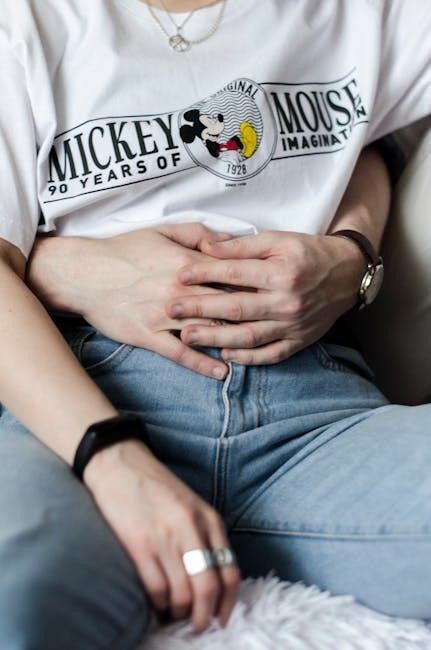Washing Techniques
Gentle hand washing or machine washing on a cool cycle is recommended. Use a mild detergent to prevent fabric damage and color fading. Avoid overloading the machine.
1.1 Hand Washing vs. Machine Washing
Hand washing is ideal for delicate or custom-printed shirts, as it prevents damage and fading. Machine washing on a gentle cycle with cool water is efficient for everyday shirts. Always check the care label to determine the best method. For machine washing, use a mild detergent to protect fabrics and colors. Avoid overloading the machine to ensure gentle agitation.
1.2 Importance of Water Temperature
Using the right water temperature is crucial for preserving shirt quality. Cool water (around 30°C) is best for most fabrics, preventing shrinkage and color fading. Hot water can damage delicate materials or cause dyes to bleed. Always check the care label for specific temperature recommendations to ensure optimal washing conditions and fabric longevity.
1.3 Choosing the Right Detergent
Choosing the right detergent is essential for maintaining shirt quality. Opt for mild, eco-friendly detergents to avoid harsh chemicals that can damage fabrics. Avoid overloading with detergent to prevent residue buildup. Always check the care label for fabric-specific recommendations. For delicate or special-care shirts, consider using a detergent designed for those materials to ensure longevity and color preservation.
Drying Methods
Air drying is ideal to prevent shrinkage and creasing. Remove shirts promptly from the dryer and reshape while slightly damp for a smoother finish.
2.1 Air Drying vs. Machine Drying
Air drying is gentler and prevents shrinkage, while machine drying is faster but risks fabric wear. Remove shirts from the dryer while slightly damp and reshape them to maintain smoothness. Always avoid overheating to preserve fabric integrity and color vibrancy. Air drying is especially recommended for delicate or printed fabrics.
2.2 Tips for Minimizing Creasing
To minimize creasing, remove shirts from the dryer while slightly damp and reshape them immediately. Hang on hangers to air dry completely, as machine drying can cause wrinkles. Avoid overloading the washing machine and consider using a fabric refresher spray. Lower temperature settings and gentle cycles also help reduce creasing and maintain fabric smoothness.

Ironing Guidelines
Iron shirts while slightly damp for easier crease removal. Cotton and linen fabrics respond best to ironing. Use a medium heat setting to avoid damaging synthetic blends.
3.1 Best Fabrics for Ironing
Cotton and linen fabrics are ideal for ironing as they hold a crisp finish. Synthetic blends like polyester can be ironed but require lower heat to prevent melting. Always iron while slightly damp for best results, as dry fabrics may resist smoothing. Use steam cautiously to avoid damaging delicate materials or prints.
3.2 Ironing While Slightly Damp
Ironing shirts while they are slightly damp ensures easier removal of wrinkles. Gently shake the garment after washing to restore its shape; Use a medium heat setting and avoid applying excessive pressure. This method works best for cotton fabrics, allowing the iron to glide smoothly and prevent creases from forming. Always iron from the collar down to the hem for a polished look.
Fabric-Specific Care
Tailor your care routine to the fabric type. Cotton shirts thrive in cool water, while synthetic blends may require specific detergents to maintain texture and color vibrancy.
4.1 Cotton Shirts
Cotton shirts prefer gentle care. Wash inside out in cool water to preserve color and softness. Avoid soaking, as it may weaken fibers. Air drying prevents shrinkage and maintains shape. Iron while slightly damp for best results, using a medium heat setting to avoid scorching. This ensures longevity and keeps cotton shirts looking fresh.
4.2 Synthetic and Blended Fabrics
Synthetic and blended fabrics require careful handling to maintain their durability and appearance. Wash in cool water using a mild detergent to prevent pilling or fading. Avoid machine drying, as high heat can damage fibers. Air drying is recommended to retain shape and texture. Ironing should be done on a low setting to prevent melting or warping of synthetic materials.
Storage and Maintenance
Store shirts in a cool, dry place to prevent moisture damage. Fold or hang neatly to maintain shape, avoiding direct sunlight to preserve colors and fabric integrity.
Folding is ideal for thicker fabrics to prevent stretching, while hanging preserves the shape of tailored shirts. Use breathable materials like cotton for storage and avoid plastic. Consider folding for casual tees and hanging for dress shirts to maintain their structure and appearance. This balance ensures longevity and reduces wrinkles effectively. Prolonged sun exposure can cause fading and weaken fabrics. Direct sunlight damages dyes and may discolour prints. Store shirts in shaded areas or use UV-blocking covers. Avoid drying shirts under direct sun to prevent fabric weakening. Opt for indoor drying or shaded outdoor areas to preserve color vibrancy and material integrity. This protects your shirts from harmful UV rays. Act quickly on stains to prevent them from setting. Blot spills with a clean cloth, avoiding rubbing. Pre-treat with mild detergents or vinegar before washing. For tough stains like ink or grease, apply stain removers. Always test a small area first to ensure colorfastness and fabric integrity are maintained. Common stains on shirts include food spills, grass, sweat, ink, and grease. Oil-based stains penetrate deeply, while acidic substances like tomato sauce can cause discoloration. Tannin-based stains, such as coffee or wine, bind to fabrics, making them challenging to remove. Identifying the stain type is crucial for effective removal, as different stains require specific cleaning approaches for optimal results. For common stains, use a mild detergent or a solution of equal parts water and white vinegar. Baking soda can lift tough stains like grease or ink. Hydrogen peroxide is effective for brightening and removing organic stains. Gently apply cleaning solutions to affected areas, let sit, then rinse thoroughly. Avoid harsh chemicals to preserve fabric integrity and colors. Gentle care preserves logos and prints. Avoid harsh chemicals, turn shirts inside out before washing, and use a soft detergent to protect designs effectively. Harsh chemicals can damage logos and prints. Opt for mild detergents without bleach or abrasive additives. Avoid fabric softeners and stain removers, as they may degrade ink quality. Always check the care label and use eco-friendly products to ensure longevity of custom designs. Turn shirts inside out before washing to shield designs from friction. Use a mesh laundry bag for added protection. Avoid hot water and harsh chemicals, as they can fade or crack prints. Opt for gentle cycles and mild detergents. Air dry instead of machine drying to prevent heat damage. This ensures logos and prints remain vibrant and intact; Wash shirts in cool water and avoid overloading the machine. Use eco-friendly detergents and gentle cycles. Air dry to prevent shrinking and fabric wear. Store neatly folded or hung to maintain shape and quality, ensuring longevity and freshness for your garments. Washing shirts less often preserves their quality and color. Only wash when visibly soiled or after heavy use. Spot clean minor stains to avoid unnecessary washing. This reduces fabric wear and fading, extending the life of your shirts. Air them out instead of washing after every wear to maintain freshness naturally. Eco-friendly detergents are biodegradable and free from harsh chemicals, making them gentler on fabrics and the environment. Opt for products designed for delicate or hand-wash cycles to preserve shirt quality. These detergents prevent color fading and fabric wear while reducing environmental impact. Using eco-friendly products ensures your shirts stay vibrant and last longer, promoting sustainable care practices.5.1 Folding vs. Hanging
5.2 Avoiding Prolonged Sun Exposure
Stain Removal and Spot Cleaning
6.1 Common Stain Types
6.2 Recommended Cleaning Solutions

Care for Logos and Prints
7.1 Avoiding Harsh Chemicals
7.2 Protecting Designs During Washing

General Garment Care Tips
8.1 Washing Less Frequently
8.2 Using Eco-Friendly Products
Avoiding Common Mistakes
Ignoring care labels and overloading the washing machine can damage shirts. Ensure to follow care instructions and maintain a reasonable wash load to protect fabrics and extend shirt lifespan.
9.1 Ignoring Care Labels
Ignoring care labels can lead to irreversible damage, such as shrinking, fading, or fabric breakdown. Always read and follow the specific instructions provided, as they are tailored to the shirt’s material and design. Neglecting these guidelines risks ruining the garment, making it essential to prioritize label advice for optimal shirt longevity and appearance.
9.2 Overloading the Washing Machine
Overloading the washing machine can cause excessive creasing and fabric strain, leading to premature wear. To prevent damage, wash shirts in smaller batches, ideally no more than five to six at a time. This reduces friction and ensures a gentler cleaning process, preserving the quality and longevity of your shirts.

Professional Advice
Consult professionals for delicate or special-care shirts. Experts recommend using eco-friendly products and gentle cycles to preserve fabric integrity and maintain vibrant colors over time.
10.1 Expert Recommendations
Experts advise reading care labels thoroughly and following instructions closely. For delicate fabrics, hand washing is recommended. Using mild detergents and avoiding hot water helps preserve colors and textures. Ironing while fabrics are slightly damp eases wrinkles without damaging materials. Professionals also suggest air drying to prevent shrinkage and maintain garment shape.
10.2 When to Seek Professional Cleaning
Professional cleaning is essential for delicate or heavily soiled shirts, especially those with intricate designs or logos. For fabrics requiring dry cleaning, consult experts to avoid damage. Stubborn stains or special-care materials also benefit from professional attention. This ensures longevity and maintains the shirt’s quality and appearance.
